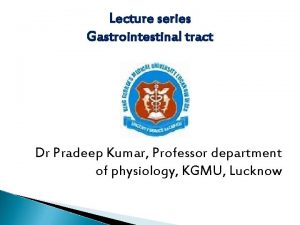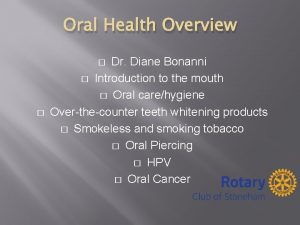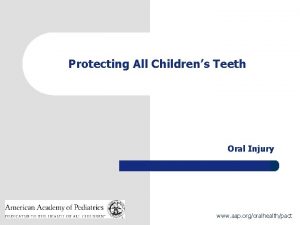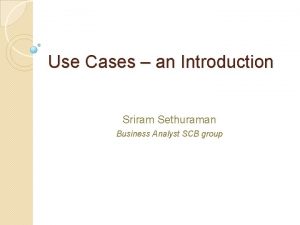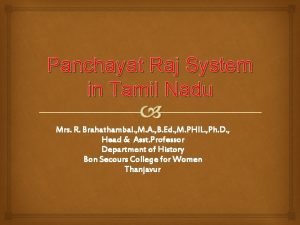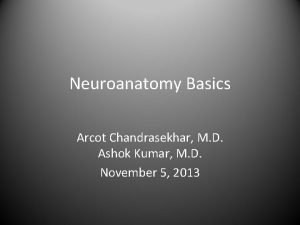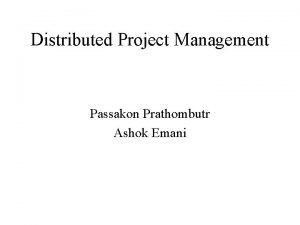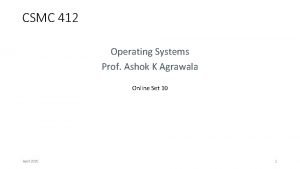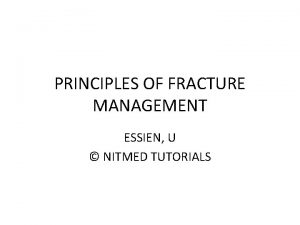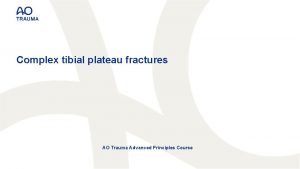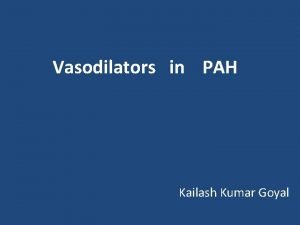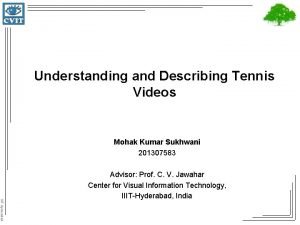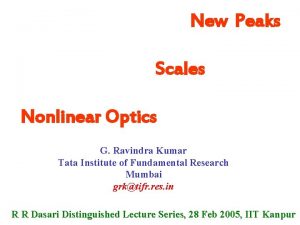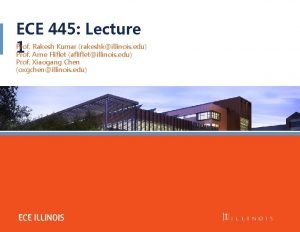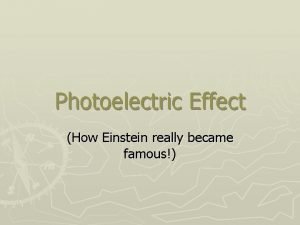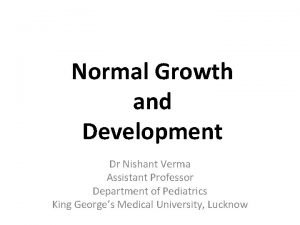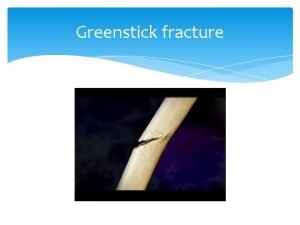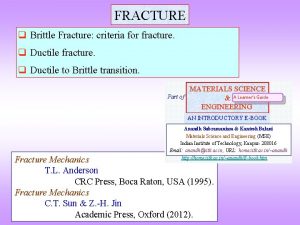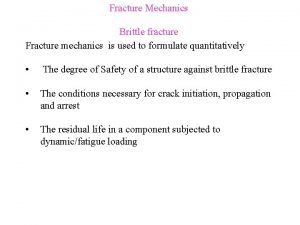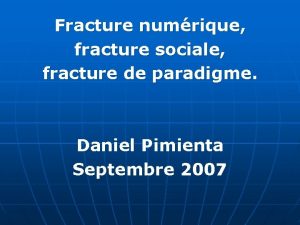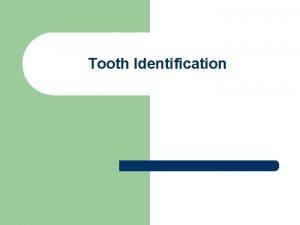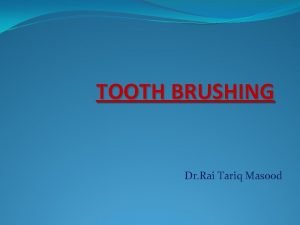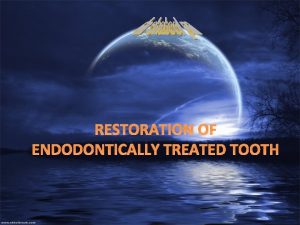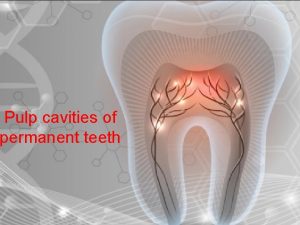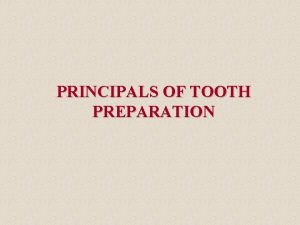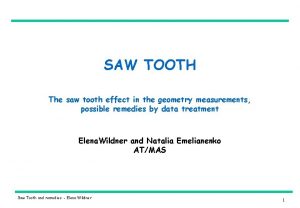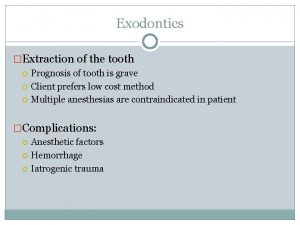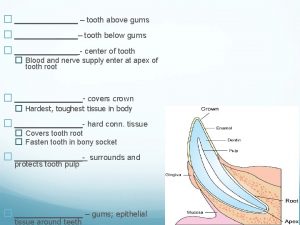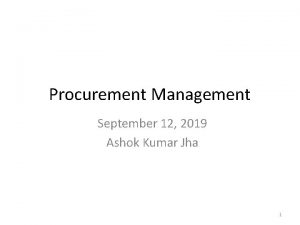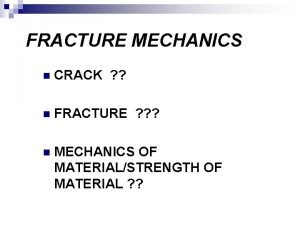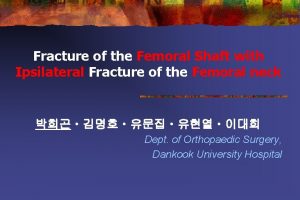TOOTH FRACTURE AND ITS MANAGEMENT Prof Ashok Kumar



















































- Slides: 51

TOOTH FRACTURE AND ITS MANAGEMENT Prof. Ashok Kumar 27 -9 - 2014

Fracture Ø Ellis and Davey classification of crown fracture is useful in recording extent of damage to crown ü Class I – simple fracture of crown involving little or no dentin ü Class II – extensive fracture of crown involving considerable dentin but not dental pulp

Fracture ü Class III – extensive fracture of crown with an exposure of dental pulp ü Class IV – loss of entire crown

Fracture Ø Enamel-Dentin-Pulp Fracture Ø Root Fracture

Enamel Fracture Ø fracture confined to the enamel with loss of tooth structure

Enamel Fracture Ø Visual sign: ü visible loss of enamel ü no visible sign of exposed dentin Ø Percussion test: ü not tender ü if tenderness is observed evaluate tooth for a possible luxation or root fracture injury

Enamel Fracture Ø Mobility test: ü normal mobility Ø Sensibility test: ü usually positive ü test may be negative initially indicating transient pulpal damage

Enamel Fracture Ø Sensibility test: ü monitor pulpal response until definitive pulpal diagnosis can be made ü test is important in assessing risk of future healing complications ü lack of response at initial examination indicates an increased risk of later pulpal necrosis

Enamel Fracture Ø Radiographic findings: ü enamel lost is visible Ø Radiographs: ü occlusal ü periapical ü recommended to rule out possible presence of root fracture or a luxation injury

Enamel Fracture Ø Treatment: ü if tooth fragment is available, it can be bonded to the tooth ü grinding or restoration with composite resin depending on extent + location of fracture

Enamel-Dentin Fracture Ø fracture confined to enamel + dentin with loss of tooth structure, but not involving pulp

Enamel-Dentin Fracture Ø Visual sign: ü visible loss of enamel + dentin ü no visible sign of exposed pulp tissue Ø Percussion test: ü not tender ü if tenderness is observed evaluate tooth for a possible luxation or root fracture injury

Enamel-Dentin Fracture Ø Mobility test: ü normal mobility Ø Sensibility test: ü usually positive ü test may be negative initially indicating transient pulpal damage

Enamel-Dentin Fracture Ø Sensibility test: ü monitor pulpal response until definitive pulpal diagnosis can be made ü test is important in assessing risk of future healing complications ü lack of response at initial examination indicates an increased risk of later pulpal necrosis

Enamel-Dentin Fracture Ø Radiographic findings: ü enamel-dentin lost is visible Ø Radiographs: ü occlusal ü periapical ü recommended to rule out displacement or possible presence of root fracture

Enamel-Dentin Fracture Ø Treatment: ü if tooth fragment is available, it can be bonded to the tooth ü otherwise perform provisional treatment by covering exposed dentin with glass ionomer or a permanent restoration using a bonding agent + composite resin

Enamel-Dentin-Pulp Fracture Ø (Complicated Crown Fracture) Ø a fracture involving enamel + dentin with loss of tooth structure + exposure of pulp

Enamel-Dentin-Pulp Fracture Ø Visual sign: ü visible loss of enamel + dentin ü exposed pulp tissue Ø Percussion test: ü not tender ü if tenderness is observed evaluate tooth for a possible luxation or root fracture injury

Enamel-Dentin-Pulp Fracture Ø Mobility test: ü normal mobility Ø Sensibility test: ü usually positive

Enamel-Dentin-Pulp Fracture Ø Sensibility test: ü test is important in assessing risk of future healing complications ü lack of response at initial examination indicates an increased risk of later pulpal necrosis

Enamel-Dentin-Pulp Fracture Ø Radiographic findings: ü lost of tooth substance is visible Ø Radiographs: ü occlusal ü periapical ü recommended to rule out displacement or possible presence of luxation or root fracture

Enamel-Dentin-Pulp Fracture Ø Treatment: ü if young patients with open apices, it is very important to preserve pulp vitality by pulp capping or partial pulpotomy in order to secure further root development ü this treatment is also treatment of choice in patients with closed apices

Enamel-Dentin-Pulp Fracture Ø Treatment: ü Calcium hydroxide compunds + MTA are suitable materials for such procedures ü in older patients with closed apices + luxation injury with displacement, root canal treatment is usually treatment of choice

Crown-Root Fracture without pulp involvement Ø fracture involving: ü enamel ü dentin ü cementum ü with loss of tooth structure ü but not exposing pulp

Crown-Root Fracture without pulp involvement Ø Visual sign: ü crown fracture extending below gingival margin Ø Percussion test: ü tender

Crown-Root Fracture without pulp involvement Ø Mobility test: ü coronal fragment mobile Ø Sensibility test: ü usually positive for apical fragment

Crown-Root Fracture without pulp involvement Ø Radiographic findings: ü apical extension of fracture usually not visible Ø Radiographs: ü occlusal ü periapical ü recommended to detect fracture lines in root ü cone beam exposure can reveal whole fracture extension

Crown-Root Fracture without pulp involvement Ø Treatment: ü Fragment removal only • removal of superficial coronal crown-root fragment • subsequent restoration of exposed dentin above gingival level

Crown-Root Fracture without pulp involvement Ø Treatment: ü Fragment removal + gingivectomy (sometimes ostectomy) • removal of coronal segment with subsequent endodontic treatment + restoration with a post-retained crown

Crown-Root Fracture without pulp involvement Ø Treatment: ü Orthodontic extrusion of apical fragment • removal of coronal segment with subsequent endodontic treatment + orthodontic extrusion of remaining root with sufficient length after extrusion to support a postretained crown

Crown-Root Fracture without pulp involvement Ø Treatment: ü Surgical extrusion • removal of mobile fractured fragment • subsequent surgical repositioning of root in a more coronal position

Crown-Root Fracture without pulp involvement Ø Treatment: ü Decoronation (root submergence) • implant solution is planned, root fragment may be left in situ after in order to avoid alveolar bone resorption • thereby maintaining volume of alveolar process for later implant installation

Crown-Root Fracture without pulp involvement Ø Treatment: ü Extraction • with immediate or delayed implant-retained crown restoration or a coventional bridge • fractures with severe apical extension, the extreme being a vertical fracture

Crown-Root Fracture with pulp involvement Ø fracture involving: ü enamel ü dentin ü cementum ü with loss of tooth structure ü exposure of pulp

Crown-Root Fracture with pulp involvement Ø Visual sign: ü crown fracture extending below gingival margin Ø Percussion test: ü tender

Crown-Root Fracture with pulp involvement Ø Mobility test: ü coronal fragment mobile Ø Sensibility test: ü usually positive for apical fragment

Crown-Root Fracture without pulp involvement Ø Radiographic findings: ü apical extension of fracture usually not visible Ø Radiographs: ü occlusal ü periapical ü cone beam exposure can reveal whole fracture extension

Crown-Root Fracture with pulp involvement Ø Treatment: ü Fragment removal + gingivectomy (sometimes ostectomy) • removal of coronal segment with subsequent endodontic treatment + restoration with a post-retained crown

Crown-Root Fracture with pulp involvement Ø Treatment: ü Orthodontic extrusion of apical fragment • removal of coronal segment with subsequent endodontic treatment + orthodontic extrusion of remaining root with sufficient length after extrusion to support a postretained crown

Crown-Root Fracture with pulp involvement Ø Treatment: ü Surgical extrusion • removal of mobile fractured fragment • subsequent surgical repositioning of root in a more coronal position

Crown-Root Fracture with pulp involvement Ø Treatment: ü Decoronation (root submergence) • implant solution is planned, root fragment may be left in situ after in order to avoid alveolar bone resorption • thereby maintaining volume of alveolar process for later implant installation

Crown-Root Fracture with pulp involvement Ø Treatment: ü Extraction • with immediate or delayed implant-retained crown restoration or a coventional bridge • fractures with severe apical extension, the extreme being a vertical fracture

Root Fracture Ø fracture confined to the root of tooth involving: ü cementum ü dentin ü pulp

Root Fracture Ø Visual sign: ü coronal segment may be mobile ü some cases displaced ü transient crown discoloration (red or gray) may occur ü bleeding from gingival sulcus may be noted

Root Fracture Ø Percussion test: ü tooth may be tender Ø Mobility test: ü coronal segment may be mobile

Root Fracture Ø Sensibility test: ü the test is important in assessing risk of healing complications ü a positive sensibility test at the initial examination indicates a significantly reduced risk of later pulpal necrosis

Root Fracture Ø Sensibility test: ü may give negative results initially ü indicating transient or permanent neural damage ü pulp sensibility test is usually negative for root fractures except for teeth with minor displacements

Root Fracture Ø Radiographic findings: ü root fracture line is usually visible ü fracture involves root of the tooth in a horizontal or diagonal plane

Root Fracture Ø Treatment: ü rinse exposed root surface with saline before repositioning ü if displaced, reposition the coronal segment of the tooth as soon as possible ü check that correct position has been reached radiographically

Root Fracture Ø Treatment: ü stabilize the tooth with flexible splint for 4 weeks ü if the root fracture is near cervical area of the tooth stabilization is beneficial for a longer period of time (upto 4 months)

Root Fracture Ø Treatment: ü monitor healing for at least 1 year to determine pulpal status ü if pulp necrosis develops, then root canal treatment of the coronal tooth segment to the fracture is indicated
 Ashok kumar pandey iit hyderabad
Ashok kumar pandey iit hyderabad An eye for an eye a tooth for a tooth sister act
An eye for an eye a tooth for a tooth sister act Prof. dr. pradeep kumar gupta
Prof. dr. pradeep kumar gupta Gruen von behrens
Gruen von behrens Ellis tooth fracture
Ellis tooth fracture Ductile vs brittle fracture surface
Ductile vs brittle fracture surface Ashok sriram md
Ashok sriram md Balwant rai mehta committee in tamil
Balwant rai mehta committee in tamil Ashok k. goel
Ashok k. goel Ashok kolaskar
Ashok kolaskar Ashok mankad
Ashok mankad Ashok chandrasekhar
Ashok chandrasekhar Ca ashok batra
Ca ashok batra Ashok emani
Ashok emani Ashok agrawala
Ashok agrawala Ashok leyland low floor bus
Ashok leyland low floor bus Ashok iptv
Ashok iptv Donnie ashok
Donnie ashok 4 sacred mountains navajo
4 sacred mountains navajo Rfm
Rfm Emigree structure
Emigree structure Its halloween its halloween the moon is full and bright
Its halloween its halloween the moon is full and bright Where are amu and kumar travelling through
Where are amu and kumar travelling through 4 r's of fracture management
4 r's of fracture management Ao tibial shaft fracture
Ao tibial shaft fracture Advanced principles of fracture management
Advanced principles of fracture management Three column concept tibial plateau
Three column concept tibial plateau When a train increases its velocity its momentum
When a train increases its velocity its momentum Rainy sunny cloudy windy
Rainy sunny cloudy windy If its a square it's a sonnet summary
If its a square it's a sonnet summary Its not easy but its worth it
Its not easy but its worth it Dr kailash kumar goyal
Dr kailash kumar goyal Mohak kumar
Mohak kumar Deepak kumar bryn mawr
Deepak kumar bryn mawr Xshhz
Xshhz Kamal kumar ips
Kamal kumar ips G ravindra kumar
G ravindra kumar Kalyan kumar hcl
Kalyan kumar hcl Ravi kumar kopparapu
Ravi kumar kopparapu Rakesh kumar uiuc
Rakesh kumar uiuc Nmf immunisation
Nmf immunisation Pavan kumar vijay
Pavan kumar vijay Kumar mangalam birla committee
Kumar mangalam birla committee Kumar mangalam birla committee
Kumar mangalam birla committee Dr anuj kumar tripathi neurosurgeon
Dr anuj kumar tripathi neurosurgeon Kumar venkitanarayanan
Kumar venkitanarayanan Kumar is producing the photoelectric effect by using
Kumar is producing the photoelectric effect by using Kumar raj kharel
Kumar raj kharel Immature pincer grasp
Immature pincer grasp Kumar n. sivarajan
Kumar n. sivarajan Emani kumar
Emani kumar Weebly sql database
Weebly sql database


